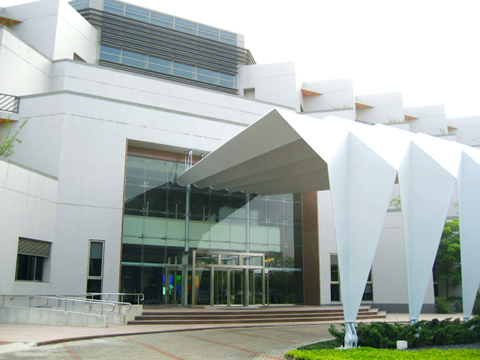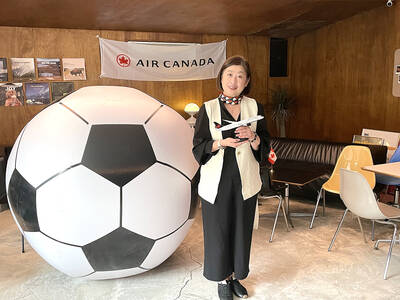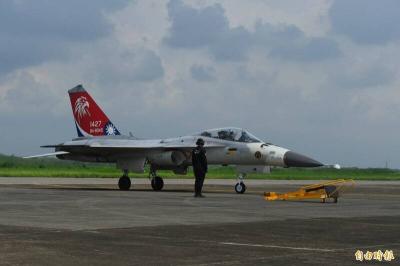Imagine an electronics plant that is surrounded by tree frogs and egrets, recycles its own electricity and turns the air conditioning off for four months a year.
The plant is Delta Electronics Inc’s (台達電子) Southern Taiwan Science Park building, and it was the nation’s first to gain gold certification in the factory-office category from the US Green Building Council.
The plant received the council’s Leadership in Energy and Environmental Design (LEED) green building rating in 2006.

PHOTO: MEGGIE LU, TAIPEI TIMES
“The building may not look impressive at first, but walk through it and you’ll notice many hidden qualities that are innovative and conserve energy,” Delta senior director of corporate communications Jesse Chou (周志宏) said last week in Tainan.
But even on the outside the factory is unusual. The exterior looks more like a resort, resembling a multi-layered cake with a flashy metal canopy at the front entrance that looks like a work of origami.
The design serves several purposes, Chou said.
“The multi-layered construction deflects sunshine that would directly enter the factory so that we can save on air-conditioning costs. Also, on each layer we can plant several trees to provide even more shade,” he said.
The metal canopy is made of an aluminum alloy; apart from its aesthetic appeal, it fends off strong winds in the winter, he said.
At either side of the factory, ponds thrive with indigenous flora and fauna. Look and listen carefully and one notices tree frogs and other creatures singing on the lotus leaves.
“Every year, more than 10,000 birds and 1.2 million insects make the eco-ponds their permanent or temporary homes,” Chou said.
In addition to a carefully designed exterior, the concrete used in the building is “green,” Chou said, as 30 percent of it is produced from scrap from steel plants.
“This is beneficial in multiple ways: Not only is it cheaper, it is lighter and 2.4 times stronger. It utilizes what would otherwise be waste and the concrete industry actually emits a lot of carbon dioxide, so using metal scraps in the concrete reduces our plant’s carbon footprint,” he said.
Moving into the building, the first thing that greets employees and visitors in the lobby is a spiral staircase.
“We intentionally put the staircase up front and hid the elevators in a corner so that more people would take the stairs,” Chou said.
The 10m high lobby also features ventilation windows at the top.
“Since hot air naturally rises, we can again save on air conditioning costs,” Chou said.
In fact, the entire building uses the principles of physics to help keep off the air-conditioning between November and March each year, he said.
The benefits of the ventilation system can best be observed in the factory’s basement parking lot, which regularly has between 200 and 300 cars inside but has an air-regulation system that has never once been turned on, Chou said.
“With ‘sky wells’ [vents that open part of the basement to exposure of ground level air and sunlight] along either side of the parking lot, air in the parking lot is smoothly exchanged with cool and clean air outside; the sky wells also mean the parking lot is partially lit by natural light,” Chou said.
Although an air regulation system was installed and would automatically switch on if the carbon monoxide level in the basement exceeded 10 parts per million, for the three years that the plant has been open, the system has remained idle, he said.
In addition to energy conservation, the Delta plant has a rainwater collection system that saves up to 50 percent of the factory’s water needs.
“The rainwater is filtered and then used to flush toilets or to water the plants; our garden watering system automatically shuts down when sensors detect that precipitation exceeds 3mm that day,” Chou said.
The factory’s design not only makes it eco-friendly, it keeps the utility bills down.
“The construction costs were about 10 percent more than a regular factory, but that extra cost is quickly recouped, as the building uses 31 percent less electricity and 50 percent less water than a regular building,” Chou said.
Delta makes alternative energy and energy-saving equipment, Chou said, adding that the mission of Delta is to provide technology that is sustainable and healthy.
For example, the Kaohsiung 2009 World Games stadium features 8,844 solar panels made by Delta, which are capable of generating 1.14 million kilowatt hours of electricity annually and is the largest solar powered construction in Taiwan to date, Chou said.
“On average, the stadium generates 3,200 kilowatt hours of electricity per day, which could power 700 to 800 households. When the stadium is not in use, the electricity can be sent to the city’s power grid to supply residents and offices,” he said.
In addition, the company’s systems for switching power supplies between alternate current, which come out of power outlets, and direct current, which electronic appliances consume, also reduces carbon emissions, Chou said.
At an information forum held by Intel and Google, experts said that by boosting power supply switching from 60 percent to 90 percent, 400 billion kilowatt hours of electricity can be saved per 100 million computers if they operate for eight hours a day for three years, Chou said.
“That is the equivalent of the output of 11 coal-fired power plants the size of Linkou,” he said.
By producing 180 million power-supply switching units annually, Delta is helping create a greener world, he said.
Delta’s contribution to the environment does not stop at selling green products and designing green buildings.
When nearby Taiwan Semiconductor Manufacturing Company (台積電, TSMC) was drawing up blueprints for its new factory, Delta’s green construction team gave it a lot of advice.
Last August, TSMC’s Plant 14 Phase 3 became Taiwan’s first recipient of the LEED gold certification in the factory category.
This year, the plant also became the first factory to receive the Ministry of the Interior’s Architecture and Building Research Institute diamond-level certification.
“We sought a lot of advice from the Delta team. The important thing is, now that we have gathered so much experience in building green factories, how do we pass this on to other companies?” said TSMC’s director of new fab’s planning and engineering division, Arthur Chuang (莊子壽).
And the green trend is being noticed by the Southern Taiwan Science Park authorities.
In a press conference last week, park director Chen Chun-wei (陳俊偉) said his ambition was to make the park the first LEED-certified science park within two years.
New buildings in the park will need to be constructed in the most environmentally friendly manner possible, Chen said, and those with construction budgets of more than NT$50 million (US$1.5 million) will need at least to meet the LEED’s lowest certification level.
The park will also work on attracting green technology plants such as solar panel firms, he said.
“The LEED rating system currently does not have guidelines for science parks. This is a huge challenge, but we want to work toward that goal,” Chan said.
Chan said that this development was vital for high-tech industries and would become the trend.
“We all know that the current economic crisis will one day pass; what will remain afterwards is prospering green technologies,” he said.

LOW RISK: Most nations do not extradite people accused of political crimes, and the UN says extradition can only happen if the act is a crime in both countries, an official said China yesterday issued wanted notices for two Taiwanese influencers, accusing them of committing “separatist acts” by criticizing Beijing, amid broadening concerns over China’s state-directed transnational repression. The Quanzhou Public Security Bureau in a notice posted online said police are offering a reward of up to 25,000 yuan (US$3,523) for information that could contribute to the investigation or apprehension of pro-Taiwanese independence YouTuber Wen Tzu-yu (溫子渝),who is known as Pa Chiung (八炯) online, and rapper Chen Po-yuan (陳柏源). Wen and Chen are suspected of spreading content that supported secession from China, slandered Chinese policies that benefit Taiwanese and discrimination against Chinese spouses of

ALIGNED THINKING: Taiwan and Japan have a mutual interest in trade, culture and engineering, and can work together for stability, Cho Jung-tai said Taiwan and Japan are two like-minded countries willing to work together to form a “safety barrier” in the Indo-Pacific region, Premier Cho Jung-tai (卓榮泰) yesterday said at the opening ceremony of the 35th Taiwan-Japan Modern Engineering and Technology Symposium in Taipei. Taiwan and Japan are close geographically and closer emotionally, he added. Citing the overflowing of a barrier lake in the Mataian River (馬太鞍溪) in September, Cho said the submersible water level sensors given by Japan during the disaster helped Taiwan monitor the lake’s water levels more accurately. Japan also provided a lot of vaccines early in the outbreak of the COVID-19 pandemic,

PROMOTION: Travelers who want a free stopover must book their flights with designated travel agents, such as Lion Travel, Holiday Tours, Cola Tour and Life Tours Air Canada yesterday said it is offering Taiwanese travelers who are headed to North America free stopovers if they transit though airports in Japan and South Korea. The promotion was launched in response to a potential rise in demand for flights to North America in June and July next year, when the US, Canada and Mexico are scheduled to jointly host the FIFA World Cup, Air Canada said. Air Canada offers services to 13 of the 16 host cities of the tournament’s soccer games, including Toronto and Vancouver; Mexico City, Guadalajara and Monterrey in Mexico; Atlanta, Georgia; Boston; Dallas; Houston;

The US approved the possible sale to Taiwan of fighter jet spare and repair parts for US$330 million, the Pentagon said late yesterday, marking the first such potential transaction since US President Donald Trump took office in January. "The proposed sale will improve the recipient's capability to meet current and future threats by maintaining the operational readiness of the recipient's fleet of F-16, C-130," and other aircraft, the Pentagon said in a statement. Trump previously said that Chinese President Xi Jinping (習近平) has told him he would not invade Taiwan while the Republican leader is in office. The announcement of the possible arms